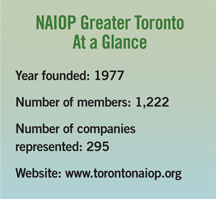Chapter Profile: NAIOP Greater Toronto

Canada’s largest city has a strong economy that’s attracting real estate investors from all over the world.
With more than 1,200 members, NAIOP Greater Toronto is one of the association’s biggest chapters. In early 2019, it was named NAIOP’s Chapter of the Year in the Large Chapter category. NAIOP Greater Toronto President Sam Barbieri, senior vice president of asset management at LaSalle Investment Management, answered a few questions about what is happening in commercial real estate in the Greater Toronto Area (GTA).
Development: How are the market conditions for member companies in your chapter?
Sam Barbieri: Toronto is experiencing some of the strongest market conditions in recent history. Bolstered by a diversified economy, a stable political climate, a diverse, multilingual and highly educated workforce, Toronto has attracted significant attention from global companies and foreign investors alike. Toronto’s burgeoning economy has positioned the city as the tightest office market among all major cities across North America. In the fourth quarter of 2018, Toronto reached its lowest office vacancy on record (1.8%) and it currently remains at an impressive 2.1%. Major global technology players Netflix, Shopify, Index Exchange, Spaces, Microsoft and WPP have all completed major lease deals in Toronto recently, accounting for more than 1.4 million square feet in newly leased space. This strong momentum is expected to continue as Toronto asserts its reputation as a global technology hub.

Development: What are the biggest challenges in either the business or regulatory climate in Ontario?
Barbieri: Inequitable taxation policies at the municipal and provincial levels of government. As governments struggle with their budgets, it is politically easier to raise taxes on businesses than on residents and individual taxpayers. Uncompetitive commercial-to-residential property tax ratios, business-related tax rates earmarked for education that favor specific regions of the province, and increased assessment pressures in urban centers are significant policy challenges for NAIOP members.
Development: Can you discuss the potential impact of Bill 108, which was recently passed by the Legislative Assembly of Ontario?
Barbieri: Bill 108 introduces a number of significant reforms that should help residential and commercial developers meet the needs of a growing Ontario while respecting the concerns of the surrounding community. With the GTA’s population growing dramatically, the act’s changes to the planning and appeal process will help address the pressure being placed on housing and office space. The reforms include new time limits for municipal decisions, changes to how development charges are assessed, and simplifying planning rules and community benefit calculations. While the legislation has been welcomed by NAIOP members, the subsequent implementation of its regulations will be something that NAIOP is closely monitoring.
Development: What are some of your chapter’s other legislative or regulatory priorities? For example, Natural Resources Canada’s Pan-Canadian Framework on Clean Growth and Climate Change seeks a 30% reduction in energy use through building efficiency. How is the chapter responding to that?
Barbieri: The Pan-Canadian Framework on Clean Growth set (but did not mandate) ambitious energy reduction targets to help guide Canada toward a greener future. A key recommendation was to develop a model “net-zero energy” code by 2030, meaning that newly constructed buildings in Canada would be essentially self-sufficient on their own renewable energy supplies. We have seen this sustainability push in the 2018 revision to the Toronto Green Standard (TGS V3) and various other bylaws from GTA municipalities. Many of these outline a set of minimum sustainability performance measures that must be met by all new developments and provide incentives for achieving superior energy and resource performance. Our chapter expects increasingly stringent sustainability requirements from all municipalities and the province going forward. NAIOP Toronto is committed to sustainability, and to helping our members navigate the changing regulatory environment by providing education and opportunities to share best practices.
Development: What are some notable projects going on right now in the GTA?
Barbieri: While there are any number of remarkable projects in various stages of development underway in the GTA, it has been especially exciting to see the explosion of new office proposals both as it relates to more traditional space in the downtown core and the planning for new employment centers such as the East Harbour site by First Gulf and Union Station West at Toronto Pearson International Airport. Other notable activity in this space includes the increasing use of timber construction (e.g. 80 Atlantic designed by Quadrangle) and ongoing discussions with Sidewalk Labs, the urban development subsidiary of Google’s parent company Alphabet, to build a “smart city” on 12 acres along Toronto’s waterfront.
Development: You mentioned your chapter’s subcommittees and the work they do. Would you like to elaborate on that?
Barbieri: The NAIOP Greater Toronto committees are formed of volunteers from the industry who are dedicated to advancing the association and commercial real estate in the GTA overall. Our committees are centered on either key functions (e.g. Programs/Suburban Programs, Membership, Government Relations), specific member groups (e.g. Developing Leaders) or platform events (e.g. Real Estate Excellence [REX] Awards, Annual Ski Day). The committees play an integral role in ensuring that the chapter’s programming and benefits are aligned with the members it serves.
Trey Barrineau is the managing editor of Development magazine.




